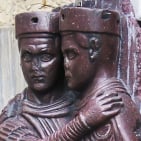Setting fractions

mauro sacchetto
Posts: 353
In setting the fractions, I note that generally the fonts have an absolute symmetry in the general dimensions, even at the cost of setting up different kernings. In the image that I attach (this is the Adobe Jenson Pro) it is noted that, for example, the 3.numr and 7.numr have a significantly different distance from the slash.

Now: is it better to aim for a homogeneous kerning or to guarantee the same amplitude for each fraction? And in the latter case, is there a specific technique to gain rigorous results, or simply a shrewd appeal to kerning?

Now: is it better to aim for a homogeneous kerning or to guarantee the same amplitude for each fraction? And in the latter case, is there a specific technique to gain rigorous results, or simply a shrewd appeal to kerning?
0
Comments
-
Fractions should be tabular, in my opinion.
Certain layouts, such as recipes, require it, where fractions may be stacked.
The numerators and denominators need space—fractions often appear next to whole numbers, so you don’t want to end up with 1¼ being a lot narrower than 5⅝.
In fact, rather than the sample above, it is better to look at fractions alongside whole numbers and alphabetic text, and match the amount of white space.2 -
1. Tabular? What do you mean, that I have to use tabular numbers for numerators and denominators?
2. Regarding to space, in practice - again - which setting do you refer to?0 -
1. Tabular?Mauro, Nick Shinn was alluding to the fact that fractions ought to be suitable for table composing, hence the rquirement of a constant width in order to secure a neat vertical alignment.0
-
But this goal can be better accomplished if I use tnum. Is it right?0
-
Make all your .numr and .dnom figures the same width.
And don’t kern them against the <fraction> character.
If you want to introduce kerning, use pre-composed fractions that each have their own Unicode.
If you are intent on proportional fractions, then have separate fractions for tnum and pnum.
1 -
I think it is best to use tabular figures with fractions, unless it is just set in ordinary text, like: “A 10km race is about 6¼ miles.”
If I remember to, I adjust the position of the fraction slash to centre visually between the numerator and denominator. You can see that 7/8 has a lot more space than 1/7 in this font (Verajja, derived from Bitstream Vera).
However, it is not very practical to force the stacking fractions to fit the figure width, or multiples of it. Here:- Figure width = 1303 funits
- Fraction width = 1303 funits
- Single stacking fraction width = 782 funits (6/10th of the figure width)
- Double stacking fraction width = 1360 funits
I just try to make the advance widths uniform for each group.1 -
This is my first attempt. I created the numerators and denominators from the tnum and I have a bit emboldened the glyphs. I created the lookups for the automatic creation of fractions, I centered the numbers compared to the slash and applied a symmetrical kerning.
 There are fairly balanced cases, others in which the spaces are visibly ill-balanced, as in 7/7.Tips to improve yield?0
There are fairly balanced cases, others in which the spaces are visibly ill-balanced, as in 7/7.Tips to improve yield?0
Categories
- All Categories
- 46 Introductions
- 3.9K Typeface Design
- 487 Type Design Critiques
- 564 Type Design Software
- 1.1K Type Design Technique & Theory
- 656 Type Business
- 861 Font Technology
- 29 Punchcutting
- 520 Typography
- 119 Type Education
- 324 Type History
- 77 Type Resources
- 112 Lettering and Calligraphy
- 33 Lettering Critiques
- 79 Lettering Technique & Theory
- 558 Announcements
- 94 Events
- 114 Job Postings
- 170 Type Releases
- 179 Miscellaneous News
- 276 About TypeDrawers
- 54 TypeDrawers Announcements
- 120 Suggestions and Bug Reports


